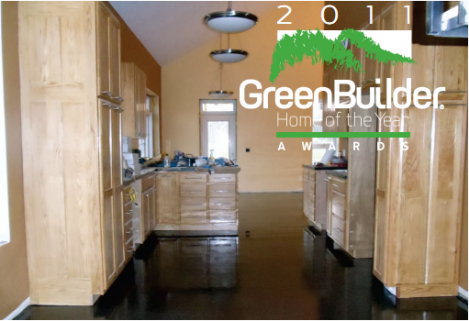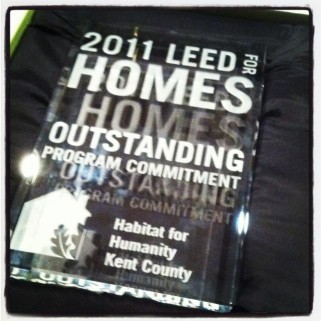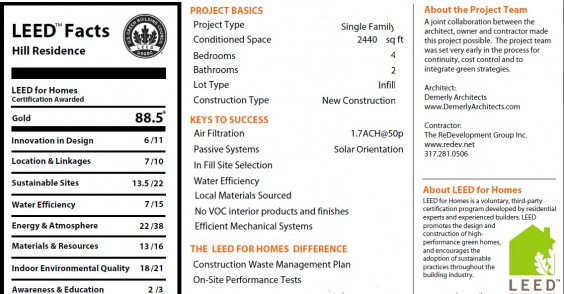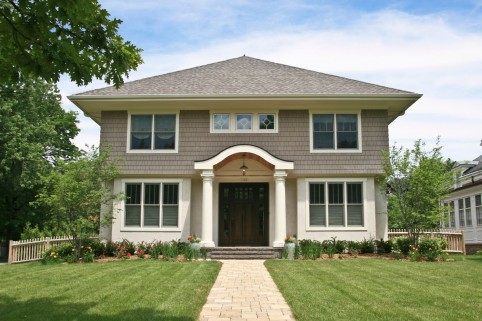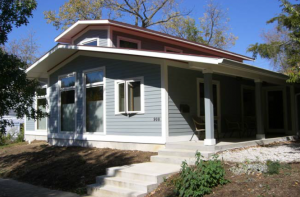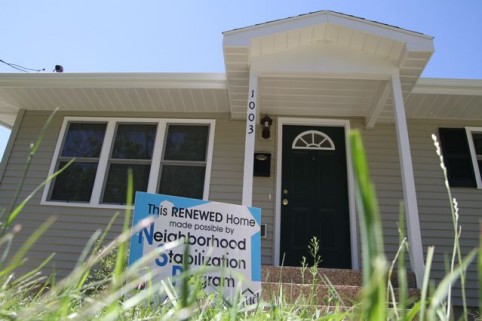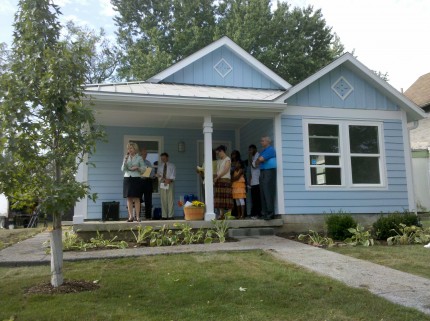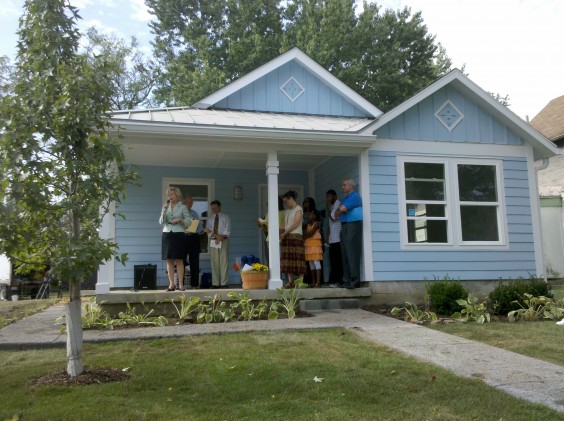LEED for Homes OUTSTANDING PROGRAM COMMITMENT Winner.
/0 Comments/in Local, Affordable Housing, Green Home Institute, Gut Rehab, LEED Gold, LEED Silver, Single-Family Projects/by Brett Little
Habitat for Humanity Kent County has won this years Green Build 2011 Award for Outstanding Program Commitment to LEED for Homes. is proud to have served Habitat for Humanity in Kent County since their commitment in 2007 to Build all LEED for Homes Silver certified projects. Habitat Kent County has been raising the bar and is completing Gold LEED certified projects and they are on their way to complete a platinum. Currently they have achieved
- 85 Registered LEED Projects
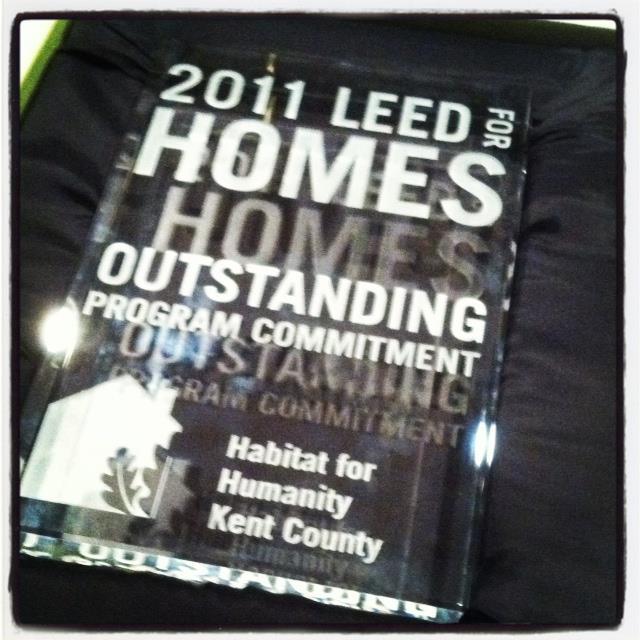
- 70 Certified LEED Projects
- 61 Average HERS Rating
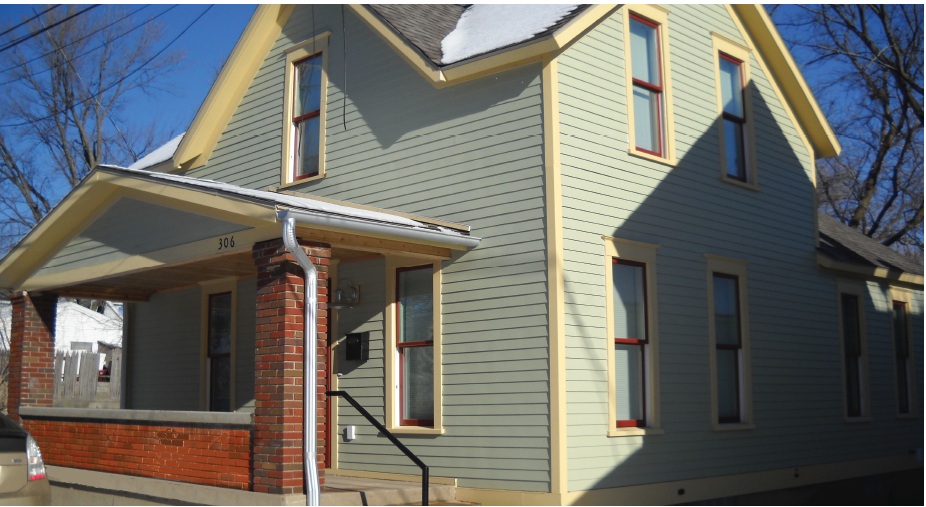 The 53 HERS score for this home was, at the time, the most energy efficient home built by Habitat Kent. This is noteworthy since the home is over a century old and was originally built to “breathe” so achieving such air-tightness wasn’t easy. This success is even more impressive considering the untrained, inexperienced labor-force of volunteers who rehabbed the home. Simply being located in a historic district also invited numerous challenges including using
The 53 HERS score for this home was, at the time, the most energy efficient home built by Habitat Kent. This is noteworthy since the home is over a century old and was originally built to “breathe” so achieving such air-tightness wasn’t easy. This success is even more impressive considering the untrained, inexperienced labor-force of volunteers who rehabbed the home. Simply being located in a historic district also invited numerous challenges including using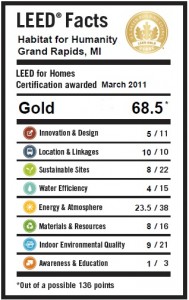 wood windows (which are notoriously inefficient). Despite these challenges, the project team hit a home run with this home. Their recent dedication to be restorative to the Wealthy Heights Community has lead to several projects that involved painting, remodeling, gut rehabbing, as well as building several new homes and creating community gardens. Habitat is completely revitalizing the area. Their highest achievement here is their commitment to constructing a net zero or near zero (currently) 5 bedroom home. This home features, ICF and SIP panel construction and has a solar hot water heater attached to the house. The homes HERS score tested out to be 35, one of the lowest in Michigan. They are still missing the Solar PV making a perfect promotion opportunity for any company willing to supply solar to this project. Please contact Chris Hall if you are interested. CJHall@habitatkent.org. Due to Habitat for Humanity of Kent Countie’s commitment to LEED certification, they have been able to attract many more sponsors, donors and volunteers. They have also been able to achieve some great accomplishments. Deconstruction of homes literally saves tons of usable materials and items from heading to the landfill. These materials are re-sold at the Habitat
wood windows (which are notoriously inefficient). Despite these challenges, the project team hit a home run with this home. Their recent dedication to be restorative to the Wealthy Heights Community has lead to several projects that involved painting, remodeling, gut rehabbing, as well as building several new homes and creating community gardens. Habitat is completely revitalizing the area. Their highest achievement here is their commitment to constructing a net zero or near zero (currently) 5 bedroom home. This home features, ICF and SIP panel construction and has a solar hot water heater attached to the house. The homes HERS score tested out to be 35, one of the lowest in Michigan. They are still missing the Solar PV making a perfect promotion opportunity for any company willing to supply solar to this project. Please contact Chris Hall if you are interested. CJHall@habitatkent.org. Due to Habitat for Humanity of Kent Countie’s commitment to LEED certification, they have been able to attract many more sponsors, donors and volunteers. They have also been able to achieve some great accomplishments. Deconstruction of homes literally saves tons of usable materials and items from heading to the landfill. These materials are re-sold at the Habitat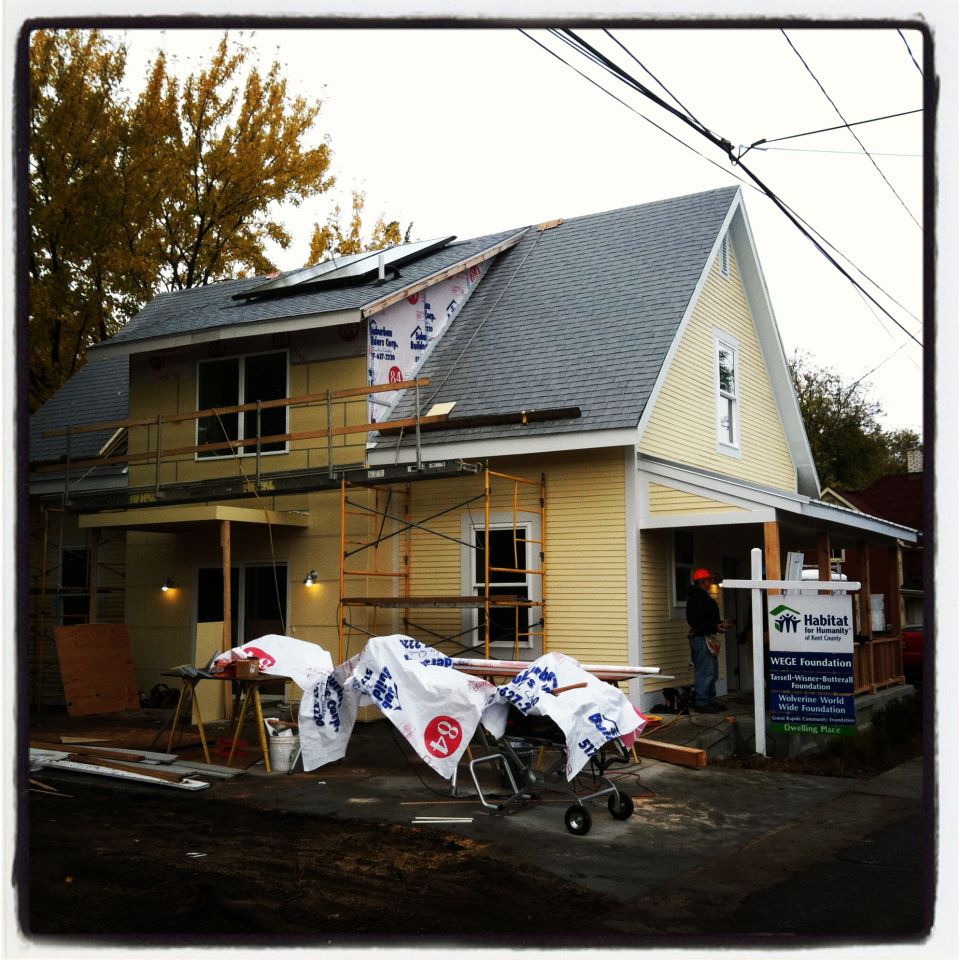 ReStore for a profit to build other homes. Habitat discovered that it costs approximately $8000 more to incorporate green building and zero-step entry into a Habitat home building per house, and that the long-term benefits to the family and the environment easily justify the expense. It is estimated (based on their earliest LEED Homes) that annual savings costs for electric, water, and heating will be at least $1,000 per home per year. The extra money available every month eases the hard decision “food or heat?” for families who live close to the poverty line. Over the life of each homebuyer’s 25 year mortgage, the savings equates to $25,000 at minimum – money a family is able to invest into strengthening their future.Looking to start a LEED for Homes or a Green Building project within your Habitat Affiliate? Please contact today. We work with over 20 other Habitat Affiliates including Detroit, Chicago, Cincinnati and Indianapolis.
ReStore for a profit to build other homes. Habitat discovered that it costs approximately $8000 more to incorporate green building and zero-step entry into a Habitat home building per house, and that the long-term benefits to the family and the environment easily justify the expense. It is estimated (based on their earliest LEED Homes) that annual savings costs for electric, water, and heating will be at least $1,000 per home per year. The extra money available every month eases the hard decision “food or heat?” for families who live close to the poverty line. Over the life of each homebuyer’s 25 year mortgage, the savings equates to $25,000 at minimum – money a family is able to invest into strengthening their future.Looking to start a LEED for Homes or a Green Building project within your Habitat Affiliate? Please contact today. We work with over 20 other Habitat Affiliates including Detroit, Chicago, Cincinnati and Indianapolis.
South East Michigan LEED Gold Certified Home
/0 Comments/in LEED Gold, Michigan, Single-Family Projects/by Brett Little‘It’s not that easy being green,” sang Kermit the Frog. While that’s often true when it comes to green building, it is definitely getting easier, say Lynn and Charlie Arnett of Grosse Pointe Park. The Arnetts and their four children, three of whom still live at home, recently moved into one of the Detroit area’s first new LEED (Leadership in Energy and Environmental Design) certified, green-built houses.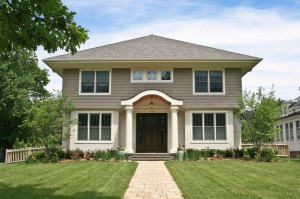
The family had been living in a nearby 1950s house and needed more space. They thought seriously about building, but empty lots are hard to find in older, established neighborhoods such as Grosse Pointe, and they weren’t sure they wanted to trade in the frustrations of an older house (asbestos, lead paint, wet basements) for the different but equally challenging issues of newer ones (formaldehyde, medium-density fiberboard).Both have long been interested in environmental issues. Lynn worked in environmental law in Washington, D.C., and Charlie, a teacher, jokes that he recently found a button for the first Earth Day in a box when they moved.
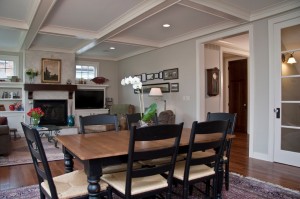 After much thought and plenty of research, they decided to look for a lot where they could build an environmentally conscious new home. Ultimately, that search led them to a 60-by-175-foot corner lot where a condemned 1920s Tudor had been torn down.“We decided we wanted to walk the walk, not just talk the talk,” says Charlie of their decision to build. Doing so had its challenges. Green building has been in the forefront of the news, but mainly in the commercial arena. Green residential building is still fairly uncharted territory, say the Arnetts, especially in Michigan. Still, they were determined to make it happen.
After much thought and plenty of research, they decided to look for a lot where they could build an environmentally conscious new home. Ultimately, that search led them to a 60-by-175-foot corner lot where a condemned 1920s Tudor had been torn down.“We decided we wanted to walk the walk, not just talk the talk,” says Charlie of their decision to build. Doing so had its challenges. Green building has been in the forefront of the news, but mainly in the commercial arena. Green residential building is still fairly uncharted territory, say the Arnetts, especially in Michigan. Still, they were determined to make it happen.
Once they found their lot, they enlisted the help of Joel Peterson of Insignia Homes, a Grand Rapids-based builder whom Lynn had worked with on a former house and who had experience in LEED-certified homes. He led them to Wayne Visbeen, a Grand Rapids-based architect known for designs that successfully blend past and present.
The Arnetts wanted the house to be green but also to blend with the older Tudors and colonials on the block. “It was very important to us that the house fit into the neighborhood,” Charlie says. “We had the architect and builder do a Grosse Pointe field trip before we started.”Priorities included a vintage-style screened porch off the kitchen as well as a large open living space encompassing the kitchen and great room. The house would have six bedrooms and 41/2 baths and the kind of detail — wood trim, glass-knobbed doors, a stucco fireplace, exterior shingles — often found in older homes. Underneath, however, the infrastructure would be green.
LEED-certified houses include things such as geothermal heat, an air recovery system and a long list of environmentally approved materials, including insulation, windows, carpet, even landscaping. “Indoor air quality is very important to us, so we opted for no-VOC paints or finishes, and insulation made of shredded newspapers,” Lynn says. LEED certification is awarded in levels, with points given for each area of compliance. (For more information, visit the U.S. Green Building Council’s website at www.usgbc.org.) The Arnetts are waiting to hear if they have achieved platinum status, the highest level given, and have been investigating the idea of installing cutting-edge solar shingles, a product Dow is pioneering.
Lynn spent hours researching materials and contractors. They struggled to find cabinetry for the kitchen that was formaldehyde-free, ending up with an Indiana company. “You really have to ask a lot of questions,” she says. “It was a big education for us, too.”It took less than a year to build the Craftsman-influenced home. Now that the house is done, they’ve been working with Grosse Pointe Park-based interior designer Fatima Beacham and trying to fill it with “green” furniture — another area that hasn’t quite hit the mainstream yet.
 “The problem with a lot of new furniture is that it is built with medium-density fiberboard that contains formaldehyde,” Lynn says. Formaldehyde has been linked to many health ailments. They admit there were times they were tempted to give in and take the easier way. “Staying on track and not letting ourselves be pressured to compromise was challenging,” Charlie says.“There were times I was tempted to cave, but Lynn kept me going.”
“The problem with a lot of new furniture is that it is built with medium-density fiberboard that contains formaldehyde,” Lynn says. Formaldehyde has been linked to many health ailments. They admit there were times they were tempted to give in and take the easier way. “Staying on track and not letting ourselves be pressured to compromise was challenging,” Charlie says.“There were times I was tempted to cave, but Lynn kept me going.”
While building green is a bit more expensive than standard construction, tax credits and governmental rebates help, and prices should decrease as demand goes up, the Arnetts say. For their family, going green has been the right choice. “Once you get started, you want to do it 100 percent,” Lynn says.“When it comes to residential construction, LEED is still in its beginning stages. We’d love to be a resource for other homeowners. Hopefully our experience will make it easier for the next folks who want to do this. Even choosing a low or no-VOC paint for your next project is a good start.
View complete project profile here
”The Arnetts recommend the following contractors and manufacturers: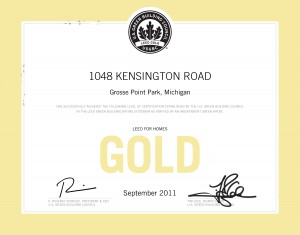
Architect: Wayne Visbeen (www.visbeen.biz)
Builder: Joel Peterson, Insignia Homes (www.insigniahomes.us)
Kitchen cabinets: Mutschler Kitchens, Karen Rozanski (www.mutschlerkitchens.com)
Flooring: Chelsea Plank Flooring (www.plankflooring.com)
Carpeting: Mohawk SmartStrand (www.mohawkflooring.com/smartstrand)
Custom cabinetry: Dutch Made Cabinetry (www.dutchmade.com)
Paint: Sherwin-Williams no-VOC “Harmony” paint (www.sherwinwilliams.com)
Toilets: TOTO Dual Flush Toilets (www.totousa.com)
Landscaping: James Leamon Landscape Design, (313) 407-8137
Khristi Zimmeth is a Metro Detroit freelance writer and Homestyle’s Trash or Treasure? columnist.
From The Detroit News: http://detnews.com/article/20110218/LIFESTYLE01/102180306/Grosse-Pointers-build-certified-earth-friendly-home#ixzz1EOaEKWMz
Video: Green built LEED Gold in Michigan
/0 Comments/in Local, LEED Credits, LEED Gold, Single-Family Projects/by Brett LittleRaymar Homes has completed and certified a LEED Gold House in Rockford, Michigan. This video displays visuals of how many points were achieved. Credits appear on the screen that correspond with visual measures of LEED points.
Raymar Homes – LEED Gold Certified
Duvernoy Residence LEED Silver
/0 Comments/in LEED Silver, Michigan, Single-Family Projects/by Brett Little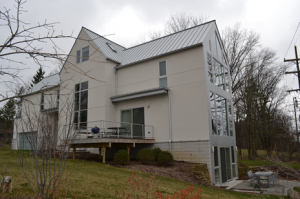 This home dramatically reduces it’s HVAC energy requirements by using airtight building principles. This home utilized geothermal forced air cooling and geothermal hydronic heating to further reduce HVAC consumption.
This home dramatically reduces it’s HVAC energy requirements by using airtight building principles. This home utilized geothermal forced air cooling and geothermal hydronic heating to further reduce HVAC consumption.
-Whole house HEPA filtration system
-Heat Recovery Ventilation System
-Energy Star Lighting and Appliances
-Advanced Building Envelope Techniques
-Sustainable Building Materials
“We achieved exemplary performance in landscape design by
greatly reducing irrigation needs. We used all drought tolerant
species and grasses and installed a rainwater harvesting system.”
David Eifrid of Greenlife Building LLC,
acted as LEED AP and Team Captain on
this project. Alexandar V Bogaerts and
Associates, P.C were the Architects,
Dave Moran of Michigan Heat LLC was
the Green Rater. Steve Pozzi was the
superintendent with Trowbridge
Homes. Michigan Energy services were
the HVAC installers and David
Czesewski assisted with the submittals.
Gulyas Residence – LEED Platinum, Bloomington Indiana
/1 Comment/in Indiana, LEED Platinum, Net Zero, Passive House, Single-Family Projects/by Brett LittleThe Gulyas Residence in Bloomington Indiana was one of the first homes in Indiana to receive LEED for Homes Platinum certification! Through the use of passive house techniques and additional sustainable design strategies this project easily met and surpassed the criteria for LEED. View the project profile here. Gulyas Residence, LEED Platinum – Bloomington Indiana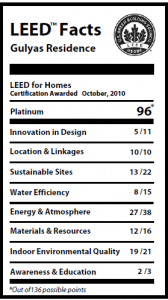
Habitat for Humanity commits to LEED and Reduces Homeowner Utilities
/1 Comment/in Affordable Housing, Economics, Gut Rehab, LEED Gold, Michigan, Single-Family Projects/by Brett LittleHabitat for Humanity Kent County Chapter has been a leader and pioneer in the field when it comes to affordable and sustainable housing. In 2006, they built the nation’s first affordable LEED certified home under the LEED for Homes pilot project. Due the success of the first home, Habitat for Humanity Kent Co made an innovative commitment in 2007 – that future families would live in homes built to minimum LEED Silver Certification. Currently, they have surpassed the Silver level and have progressed to LEED Gold Certified Homes as their new standard house.
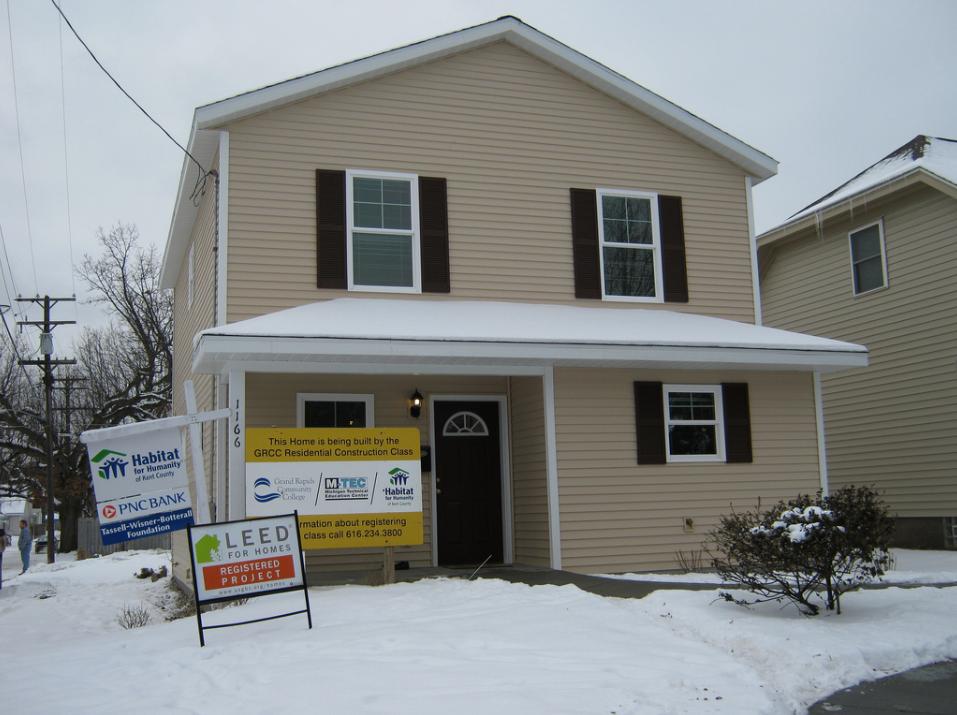
View/Download Complete project profile with LEED score and checklist here.
The Lee House was deconstructed and rebuilt after a fire had burned down the original home (see below). Habitat partnered with GRCC Tassell M-TEC students and instructor Duane McIntyre to build this 5-bedroom two story “Gervais” plan. It is “ZeroStep Certified” to be accessible, and also achieved LEED for Homes Gold Certification. Its 52 Home Energy Rating System score makes this one of Habitat Kent County’s most energy efficient home to date.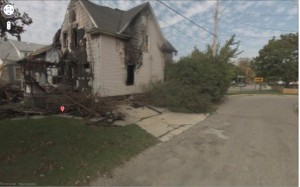
To date Habitat for Humanity Kent County has achieved great strides with LEED certification. They have built over 300 homes since they started in Kent County and certified 68 of those homes under the LEED rating system. They have registered 83 as of March 31st 2011 (with more to come!).
LEED Gut Rehabs of existing homes: 19
Average HERS score: 62.1
New Construction LEED Homes: 49
Average HERS score: 61.7
Average Square foot of Conditioned floor area: 1,750
This Habitat affiliate has built to the LEED standard in cities such as Sparta, Grand Rapids, Wyoming, Allendale, Cutlerville, Wayland all in Kent County, Michigan.
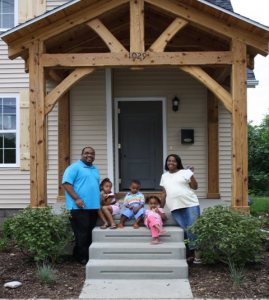 The latest home was a total gut-rehab project, made possible by the City of Grand Rapids and HUD via the Neighborhood Stabilization Project (NSP). It has achieved the coveted LEED for Homes Gold certification and will offer the hard-working Lee family a very energy efficient home.
The latest home was a total gut-rehab project, made possible by the City of Grand Rapids and HUD via the Neighborhood Stabilization Project (NSP). It has achieved the coveted LEED for Homes Gold certification and will offer the hard-working Lee family a very energy efficient home.
A unique post and beam Generations timber frame porch made from reclaimed power poles will grace the front of this home– easily the most challenging rehab project HFHKC has undertaken.
View/Download Complete project profile with LEED score and checklist here.
Due to Habitat for Humanity of Kent Counties commitment to LEED certification, they have been able to attract many more sponsors, donors and volunteers. They have also been able to achieve some great accomplishments.
Deconstruction of homes literally saves tons of usable materials and items from heading to the landfill. These materials are re-sold at the Habitat ReStore for a profit to build other homes.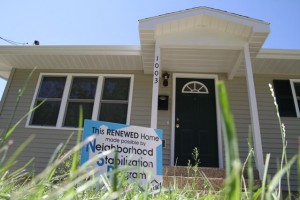
Thirty young construction students were educated in current green building practices and upon graduation, will bring those skills onto the local construction scene.
Habitat discovered that it costs approximately $8000 more to incorporate green building and zero-step entry into a Habitat home building per house, and that the long-term benefits to the family and the environment easily justify the expense.
It is estimated (based on their earliest LEED Homes) that annual savings costs for electric, water, and heating will be at least $1,000 per home per year. The extra money available every month eases the hard decision “food or heat?” for families who live close to the poverty line.
Over the life of each homebuyer’s 25 year mortgage, the savings equates to $25,000 at minimum – money a family is able to invest into strengthening their future.
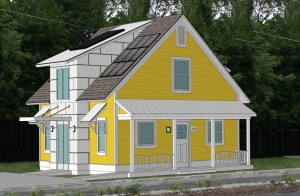 The future looks bright for Habitat for Humanity and Green Building. They now have LEED Platinum and Zero Energy / Net Zero homes under-construction. They are partnering with over a dozen organizations to continue revitalization efforts in the Wealthy Heights Neighborhood of Grand Rapids. They may be looking towards LEED ND certification for their neighborhood redevelopment plans.
The future looks bright for Habitat for Humanity and Green Building. They now have LEED Platinum and Zero Energy / Net Zero homes under-construction. They are partnering with over a dozen organizations to continue revitalization efforts in the Wealthy Heights Neighborhood of Grand Rapids. They may be looking towards LEED ND certification for their neighborhood redevelopment plans.
Indy Habitat for Humanity LEED Platinum Home!
/0 Comments/in Affordable Housing, Indiana, LEED Platinum, Single-Family Projects/by Brett LittleResidential Green Builders, USGBC’s local LEED For Homes advocacy group in Indianapolis, is currently working with Habitat again for another LEED home to start construction in July. If you are interested in getting some project experience in LEED for Homes please contact Christin Kappel or William Wagnon– the planning phase is going on now, so the sooner you join in the more you’ll learn.
Thank you to Habitat for Humanity for allowing us to be involved in this milestone and for all of their hard work and dedication to this project. Congratulations to you all!
For more information about this and other projects check out the USGBC Indiana’s 2010 Annual Report.
We look forward to working with Habitat for more affordable green homes in the future!
News videos of LEED Gut Rehab
/0 Comments/in Gut Rehab, Illinois, Indiana, LEED Platinum, Michigan, Minnesota, Net Zero, Ohio, Single-Family Projects, Wisconsin/by Brett LittleA recent project in Chicago has garnered national media attention. Here are links to a few of the highlights:
FOX – Chicago
NBC – Chicago
Menu
GreenHome Institute
GreenHome Institute
ATTN José Reyna
1451 Lake Drive SE, #6484
Grand Rapids, MI 49516
Tel: (616) 458-6733
Email: info@greenhomeinstitute.org
About Us
Recent Posts
- April 2024 GreenHome and Sustainability Jobs Round-Up.
- Protected: Public comment on Inflation Reduction Act Home Rebates opening in MI and beyond
- Shawn Neinhouse completed Certified GreenHome Professional Training
- Please take this MSU Student’s Mass Timber Survey
- Clean Energy Credit Union Clean Energy For All Reduces Barriers

